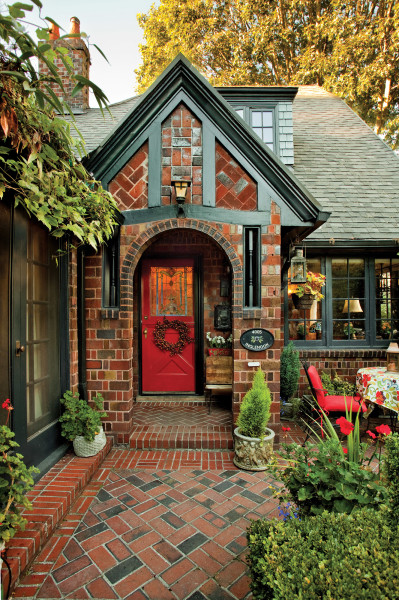
A 1920s Tudor home.
Blackstoneedge.com
Interpreting Tudor
A Glossary of Tudor Styles
Tudor: Refers to the first half of the 16th century and the reigns of the Tudor monarchs (1485–1558): Henry VII, Henry VIII, Edward VI, and Mary I. Like Elizabethan and Jacobean, Tudor falls between the Perpendicular Gothic before it and the classical Palladian style that would follow. Houses of the Tudor period are known for their domesticity; less like the fortresses of the past, they offered specialized rooms for study, dining, and sleeping. Finishes included linen-fold paneling and plaster relief ceilings. Mullioned (divided) windows and oriels, flattened Tudor arches, brickwork combined with half-timber construction, tall gables, and decorative chimneys predominated.
Tudor Gothic: Suggests the continuing influence of the Gothic during the early Tudor period. Turning their attention to domestic building, church craftsmen continued in the Gothic tradition but began to adapt Renaissance motifs. Heavy (timber) construction predominated.
Elizabethan: The “golden era” defined by the reign of Queen Elizabeth I (1558–1603). Literature and poetry flourished in this time of Shakespeare and the English Renaissance. The style designation “Tudor” is often assumed to include this period’s influence.
Jacobean: A reference to the reign of King James I (1603–1625). It is the second, more obviously Renaissance period of English architecture, after the Elizabethan.
Jacobethan: A word coined in the 1930s to refer to English Revival architecture after 1830 that combined elements of Elizabethan and Jacobean architecture. In the early 20th century, American “baronial” houses were called Jacobethan.
Tudor Revival: Understood to be a conscious, romantic revival of late- and post-medieval vernacular architecture, starting with designer William Morris and architect Richard Norman Shaw in England during the 19th century. The sweeping, so-named Tudor Revival in America was an Anglophile phenomenon in the suburbs of the 1920s and later. Another Tudor Revival occurred during the 1970s; those houses were often called Mock Tudor.
Stockbroker Tudor: A pointed reference to the bourgeois houses of the 1920s built by conservative new money.
Recommended Reading
Arts & Crafts Homes of Great Britain
By Brian D. Coleman (Gibbs Smith, 2005)
A guide to the great Arts & Crafts houses of England’s vernacular revival period.
Tudor Style: Tudor Revival Houses in America from 1890 to the Present
By Lee Goff (Universe Publishing, 2002)
From New York to Lake Forest (IL) and St. Louis to Los Angeles, here are notable Tudor houses that span decades, including new houses in the English Tudor mold. The first and only book devoted to American Tudor style.
The English House: English Country Houses and Interiors
By Sally Griffiths & Simon McBride (Rizzoli, 2004)
Real English houses from the Georgian Palladian era to 20th-century cottages. Good for background in English architectural motifs and decorating.







